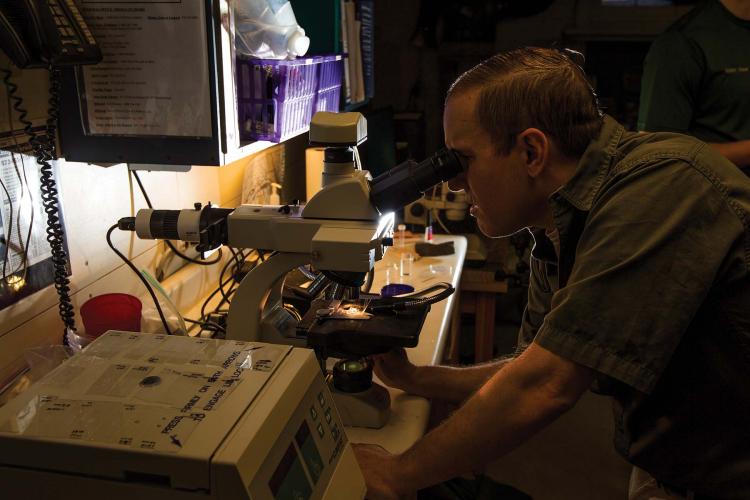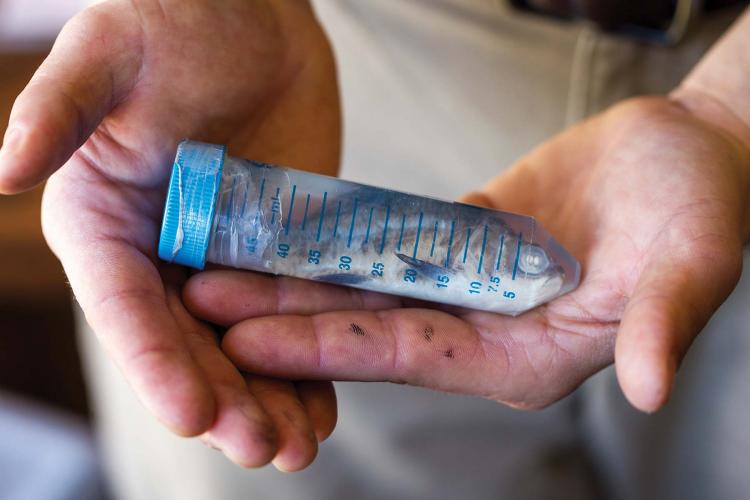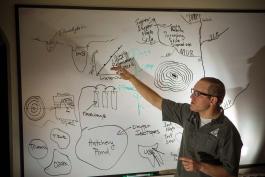How Big Are Big Rivers?
Phelps and Resource Scientist Sara Tripp work with Supervisor Dave Herzog and the rest of the research team at the Big Rivers and Wetlands Field Station in Jackson. They operate out of a 1950s ranch-style house, but their work is quite literally cutting edge. The dining room serves as a computer lab, and the basement stores racks of carefully labeled samples, as well as a precision saw, which they use to prepare bone samples for analysis. Their findings help agencies and other managers, such as the Army Corps of Engineers and the U.S. Fish and Wildlife Service, better understand the workings of big river and wetlands systems within the state’s borders and beyond.
“We’re discovering that big rivers are even bigger than we thought,” Herzog said.
In fact, the Mississippi River Basin and its tributaries are part of a migration route that, for some kinds of fish like the American eel, can stretch as far as the Sargasso Sea, south of Bermuda.
Fish migrations, however, are invisible to us. “It’s easy to see the migration patterns of butterflies, birds, and mammals,” Tripp said. “These animals travel where we can watch them — in the air and on land. When we look at a river or an ocean, we see water but not the animals that live and migrate within it.
“We don’t know that there isn’t a monarch in the fish world,” Tripp said.
Swimways Are Like Flyways
Her comment reminds us that the monarch butterfly’s recent decline has inspired agencies, nonprofits, local communities, and garden clubs all along the monarch’s migration route from Mexico to Canada to plant milkweeds
and other native wildflowers to sustain them throughout their annual migrations.
The team’s work with microchemistry, telemetry, and other techniques can help managers do the same for migrating fish, such as the endangered pallid sturgeon. “Our efforts can guide managers to make adjustments at sensitive places and moments in a fish’s life cycle — breeding, hatching, and migration,” Herzog said.
Trace Elements Tell a Story
As a tracking tool, microchemistry is possible for two reasons: different environments have different trace elements and isotope signatures, and animals record these signatures in their bones. Fish, mammals (including humans), and birds absorb and store elements from every place where they eat and drink. As Herzog said, “You’ve heard, ‘you are what you eat?’ Turns out another adage may be true: you are a product of your environment.”
Our bones store the chemical timelines of the places where we have lived. Much like growth rings can reveal a tree’s age and environmental conditions during each year of its life, an animal’s bone can reveal what elements it encountered and when and where it encountered them. “Boiled down, microchemistry is using trace elements to help us tell a story about an organism or group of organisms,” Phelps said.
How the Process Works
Using simple drawings and symbols to explain complicated terms, Phelps demonstrates how the microchemistry process works.
We Know the Basin’s Signature
Phelps sketches a rough map of the Mississippi River Basin, showing where the Missouri, the Illinois, and the Ohio rivers flow in. Before Phelps’ team can correlate a fish’s bone chemistry to its environment, they need to have an accurate elemental map of North American rivers. “Our partners have been collecting water samples from the entire basin for the last 15 years. This mapping gives us space-and-time insight into chemistry throughout the whole basin.” For example, they know the upper Missouri River has a high strontium-to-calcium ratio that decreases as it approaches the Mississippi River.
Fish Eat Yummy Isotopes
Phelps draws a little cartoon of a baby fish in a pond. He notes that non-flowing disconnected river sloughs can harbor high concentrations of nutrients marked with isotopes of common elements. When young fish are exposed to uniquely marked isotope environments, their bones store these markers. Because bone rings develop during cycles of warm and cold, the rings can record daily temperature changes too, providing scientists with even more information about changes in fishes’ local environments.
We Pick a Bone
Phelps draws a cross-section of an otolith, also known as an “ear stone.” It looks a lot like a tree “cookie,” with visible growth rings. “Otoliths are paired structures made of calcium carbonate and other trace metals such as strontium, barium, and magnesium,” he said.
Located in a fish’s head, ear stones help it hear and maintain balance. These structures form when the fish hatches and continue to grow, layer by layer, throughout the fish’s life. Fin rays are another bony part where fish store records of the chemical components in proportion to the environment in which they live. “Otoliths and fin rays are perpetual records of where fish have been and when they were there,” Phelps said. “If we cut across these bones, you can see the growth rings, which are called annuli.” Just like trees, which put on new growth rings every year, fish bones make a new ring that records a fish’s movement into different waters throughout the year.
“Put simply,” he said, “the environment a fish inhabits at any particular time determines the chemical makeup of each ring.”
We Prep the Sample
“So,” Phelps said, “now that we know the properties of otoliths and water chemistry — and the synergy between them — what’s the process of figuring out where the fish came from?” To explore the answer to this question, we go downstairs to the basement. This is where a team of Southeast Missouri State University graduate students help Phelps organize and prepare samples for analysis. He introduces me to Seth Love, who carefully cuts a fin ray from a sample fish. “The advantage of using the fin ray instead of the otoliths is that I can take a sample without sacrificing the fish.”
Then Love uses a small precision saw to cut a thin wafer of bone. The next step is to dry and polish this sample, which takes several hours.
Meanwhile …
We Fire Up the Old Plasma Mass Spectrometer
Not quite. Turns out a plasma mass spectrometer is an expensive piece of equipment, one that you wouldn’t keep in the basement of an old house.
“We contract with a specialized lab to process the samples for analysis,” Herzog said.
There, the team uses a laser to burn a section across the sample and record the location of each annulus or growth ring. Then they examine the chemical composition of the particles produced at each ring on the sample. Using the sample’s chemical data coupled with the chemistry data from the waters the fish inhabited or may have inhabited in the past, they can determine the frequency and timing of a fish’s movement between chemically distinct locations. “In the end, fish microchemistry offers a reliable way to track the movement patterns of fish in large bodies of water,” Phelps said.
A Holy Grail of Information
After his presentation, Phelps shows me a clear plastic tube. He cradles it like it’s a bar of gold. “This,” he said, “is the Holy Grail.”
The tube is a vessel, yes, but there’s a dead fish in it. Wasn’t the Holy Grail supposed to be flowing with good things? Eternal youth and food in abundance? I suppose you could eat the fish, but … “What do you mean?” I ask. “It’s a young-of-the-year black carp. It wasn’t supposed to be here. But last month we found it.”
That was January 2016. Before then, scientists thought black carp, an Asian species imported to control snails in freshwater fish farms, couldn’t breed in the wild. Unfortunately, Phelps’ Holy Grail specimen proved this assumption wrong. Unfortunate because black carp are death on native freshwater mussels. Sad because the Mississippi River Basin has the most diverse freshwater mussel population in the world. Sadder still because 75 percent of the region’s freshwater mussel species are threatened or endangered, and proof of a breeding population of mussel murdering black carp could spell doom for them.
Herzog explains why his team views this discovery as the Holy Grail. “It helps us act sooner rather than later. We can use microchemistry to find out where these fish are breeding. Understanding their early life history could help us prevent them from becoming adults. How do they spawn? How do they survive? Our role is to explore and propose early solutions.”
Microchemistry gives scientists a way to link a fish’s movement patterns to specific locations it uses for spawning, feeding, and refuge throughout its life. Using this tool, scientists have learned that fish move freely among rivers and across many state boundaries, each regulated by different agencies. In order to effectively manage or restore these highly mobile fish populations, agencies are challenged to begin or increase their interjurisdictional management. Microchemistry has endless potential in fisheries management, both in state and across borders, and it will eventually be a common choice in the toolbox of every fisheries biologist.
Tracing Swimway Connections
Just as migratory birds follow flyways, migratory fish follow swimways. The American eel is an astonishing example. Bred and born deep in the Sargasso Sea south of Bermuda, adult American eels range into estuaries along the east coast and Gulf of Mexico. Predominantly only the females migrate up into freshwater streams.
Why? “Probably to find the nutrition they need to fuel migration back to their breeding grounds,” Tripp said. “We really don’t understand why a lot of animals do what we observe them doing. That’s why we use tools like microchemistry and telemetry to help measure the extent of their range and quantify their behavior.”
More About the Big Rivers and Wetlands Field Station
“I’m very proud we are part of such an amazing river-monitoring program,” Herzog said.
The Big Rivers and Wetlands Field Station (BRWFS) was established on Jan. 2, 1991, the last field station added to the Upper Mississippi River Restoration Program. It is the only field station located on the open reach of the Upper Mississippi River.
BRWFS staff is involved in a variety of activities including research, planning, and education programs. Their primary responsibility is to carry out the Missouri Department of Conservation’s mission as it relates to the state’s large rivers. Learn more about BRWFS work and accomplishments at on.doi.gov/1YFBrVS.












Also In This Issue


And More...
This Issue's Staff
Art Director - Cliff White
Associate Editor - Bonnie Chasteen
Staff Writer - Heather Feeler
Staff Writer - Kristie Hilgedick
Staff Writer - Joe Jerek
Photographer - Noppadol Paothong
Photographer - David Stonner
Designer - Les Fortenberry
Designer - Marci Porter
Designer - Stephanie Thurber
Circulation - Laura Scheuler






















